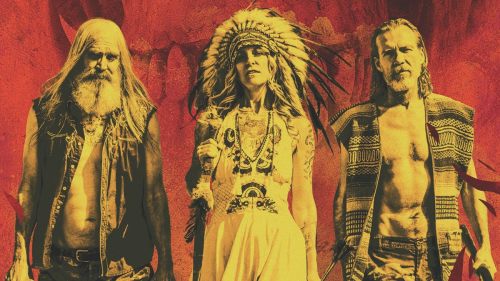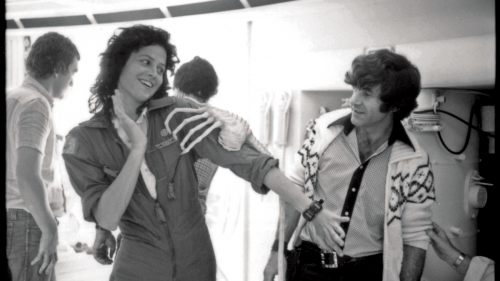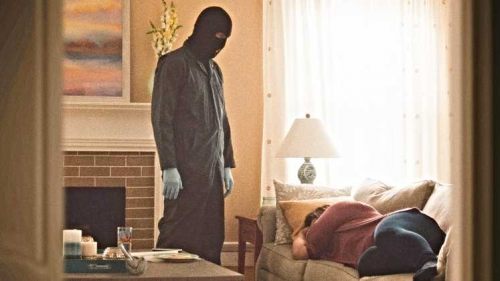Interview: CARS 3 Director Brian Fee And Producer Kevin Reher Talk Pixar’s Latest
Cars 3 does what its predecessors were mostly incapable of. It has meaning. Its story of an aging veteran passing down his knowledge to a younger, female character who doesn't yet believe in herself has resonance, especially when that female character, Cruz Ramirez (played by Cristela Alonzo) is a Latina. Trump, border walls, and all that. Heady stuff for a movie about talking cars, but there it is. I spoke to first-time director Brian Fee and producer Kevin Reher about how intentional the topical nature of the film was, if they had always intended for the young car to be Hispanic, and what's next for the Cars franchise.
---------------------
Birth.Movies.Death: First of all, let me ask you guys what was the motivation behind doing a third Cars movie? You know, this is a different tone from the second one. The second one was maybe a bit more of, like, a spy adventure and this is kind of a back to basics thing. So what was the creative process behind coming up with this third movie?
Brian Fee (Director): Well, we wanted to go back to McQueen, y'know, having him as the main character. We wanted to go back to the roots of the franchise. And, we were, even really early on, and movies go through such an evolution, as we find the plot, the right way to tell the story, but even really early on, we were really interested in this idea that McQueen is aging, you know, as a racer. And Doc being his mentor...I like to think of them as father and son, really. And Doc having passed on and [McQueen] having to face new challenges, and quite frankly, the biggest challenge he’s ever had to face without being able to call on his mentor. That was the original conceit, the little spark, the little candle that we tried to keep glowing through all the evolutionary process.
Kevin Reher (Producer): You know, the aging of an athlete. It’s been ten or eleven years, so where does Lightning McQueen find himself? We were inspired very much by Jeff Gordon and his story. Two years ago he was starting to retire and, y'know, he never thought he’d be any better than he is now or as good as anything. He’s only 40-years-old.
Brian, this is your first directorial assignment. Were there any challenges for you picking up after John Lassiter did the first two and finding your sea legs in this big job?
B: Yeah, there was, you know. There were numerous challenges. It’s a hard job. I think it’s a hard job for anybody no matter how many movies you’ve even directed. I get to watch all these seasoned directors and every time a seasoned director even is working on another film, it’s just, you know, you reach those spots where it’s just hard. I had the extra challenge of just learning how to direct. How do you communicate with all these departments that I’m unfamiliar with. But I also had the support of the studio--
K: - And the support of John.
B: - Yeah, John Lassiter’s right down the hall. We called him a lot. One of the first things I did after I just wanted to scream for a while out of terror. I never thought that I was gonna direct this movie, that’s not something I was looking for or aiming for. John called me into his office and told me I was gonna direct this movie. So, after I screamed for five minutes in my head, one of the first things I did was just call on every director in the building and try to learn from them, ask them what they wish knew, for any advice. And I did that the entire process, every step of the way I was trying to meet with everybody and ask them, and just kinda feel them out for anything I could learn.
D: One of the things I want to talk about - and this is obviously spoiler territory - is the ending. You’ve built this up to be about Lightning and trying to find his mojo and get his groove back, and then it becomes more of a story about him knowing when to step aside and being a mentor for Cruise. That's a big twist. Was that always intended?
B: We go through evolutions. It was actually in the original pitch of the movie, a version of that. And then we go down different roads, trying to find the best way to tell a story. With a couple of versions we kinda let that go for a little while and then came back in the end ‘cause it was the right thing to do.
That was originally inspired by my daughters. I have two daughters and I did an art lesson with them, because I have an illustration degree. And I wanted to show them that their little crayon drawings are no different than a real painting. The only difference is that the person who did the real, finished painting spent longer. They sat down and they spent longer. So I did a little - I wanted to demystify the process for them, so I set up one of the their dolls and I was gonna do a demonstration and paint it. And after twenty minutes, they got bored and ran off and they played. But I kept at it, kept at it for hours, because I wanted to show them the final product. And I did. So when I finally showed them the doll painting, you know, they just thought, “Eh, that’s cool, Dad.” Not really impressed and they went off and played.
And I thought I had missed my time. You know, I have a million things I could be doing for myself and what do I have? I spent all day on a Saturday and I have a painting of a child’s doll to show for it. And a week later, I went to my oldest daughter Lucia’s room and she had these drawings in her room where she had set up her stuffed animals and she was drawing their portrait. And at that moment, you know, I kinda realized that that painting of a doll might have been one of the most important pieces of art I’ve ever painted. It’s that feeling of being so proud of helping someone else and watching them. Stepping back out of the spotlight and watching them a bow and feeling like you’re more proud to have helped them than you were to do anything for yourself. That’s the emotion that I wanted McQueen to go through and what’s fueling where this movie goes. McQueen’s angle.
D: It’s also interesting to me - if you’re to apply human cultural issues to animated cars - that this character who Lightning takes under his wing is a Hispanic woman/car. Was there ever the thought that we’re trying to make a statement about the real world and real world issues through the lens of this animated film?
B: I mean, not topically meaning right now.
K: Our first writer, six years ago, came up with the name Cruise Ramirez. That’s kind of a cool name and it stuck. I don’t think we inherited it, but it was always in the DNA of the show. That there was going to be a character called Cruise Ramirez.
B: And again, I have two daughters, and one of our reps Kiel Murray, she has two daughters as well. And we're both starting to see the world through the eyes of our daughters. And we want to make sure that there’s, with Cruise in particular, a character who can inspire them. You know, reality is such a male-dominated sport. We work in an industry that’s male-dominated and we’re surrounded every day by women in a male-dominated industry, so there’s something interesting there. We wanted to be able to tell a story about how you can break through in that world. We were doing this a couple years ago, so the stuff that’s in the front pages of the newspapers today is coincidental.
Yeah.
B: Can’t turn a movie around that fast!
Of course. Last question: Are there plans for a Cars 4?
K: You know, if you’ve got a good idea, send it to me. We always try to start with an idea, including originals. There’s gotta be a kernel of something in a story that the director wants to tell, because we are a director-driven studio. And right now, there’s no plans for a Cars 4, but if somebody had a good idea and John liked it, we might put it through, just like anything. Another sequel to Ratatouille, for instance. This one took six years in the making, so it won’t be tomorrow, for sure.



